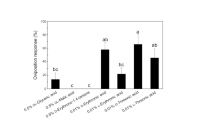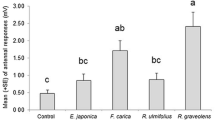Summary.
Two recently identified compounds ("CIFs"), present on the leaf surface of Brassica oleracea (cabbage), are the strongest oviposition stimulants known for the cabbage root fly, Delia radicum. Cabbage leaves contain these compounds in extremely low concentrations, and the amount of CIFs obtained from purifying leaf extracts was so small that it limited further research. We were able to purify far more of these two compounds from the roots of Brassica napus var. napobrassica (rutabaga). Apart from being a richer source of CIFs, rutabaga roots are considerably easier to collect and process than leaves. In addition, we isolated and identified a new CIF compound from the roots that is also very active in stimulating oviposition in the cabbage root fly.
Similar content being viewed by others
Author information
Authors and Affiliations
Additional information
Received 26 May 2000; accepted 26 July 2000
Rights and permissions
About this article
Cite this article
de Jong, R., Maher, N., Patrian, B. et al. Rutabaga roots, a rich source of oviposition stimulants for the cabbage root fly. Chemoecology 10, 205–209 (2000). https://doi.org/10.1007/PL00001824
Issue Date:
DOI: https://doi.org/10.1007/PL00001824




